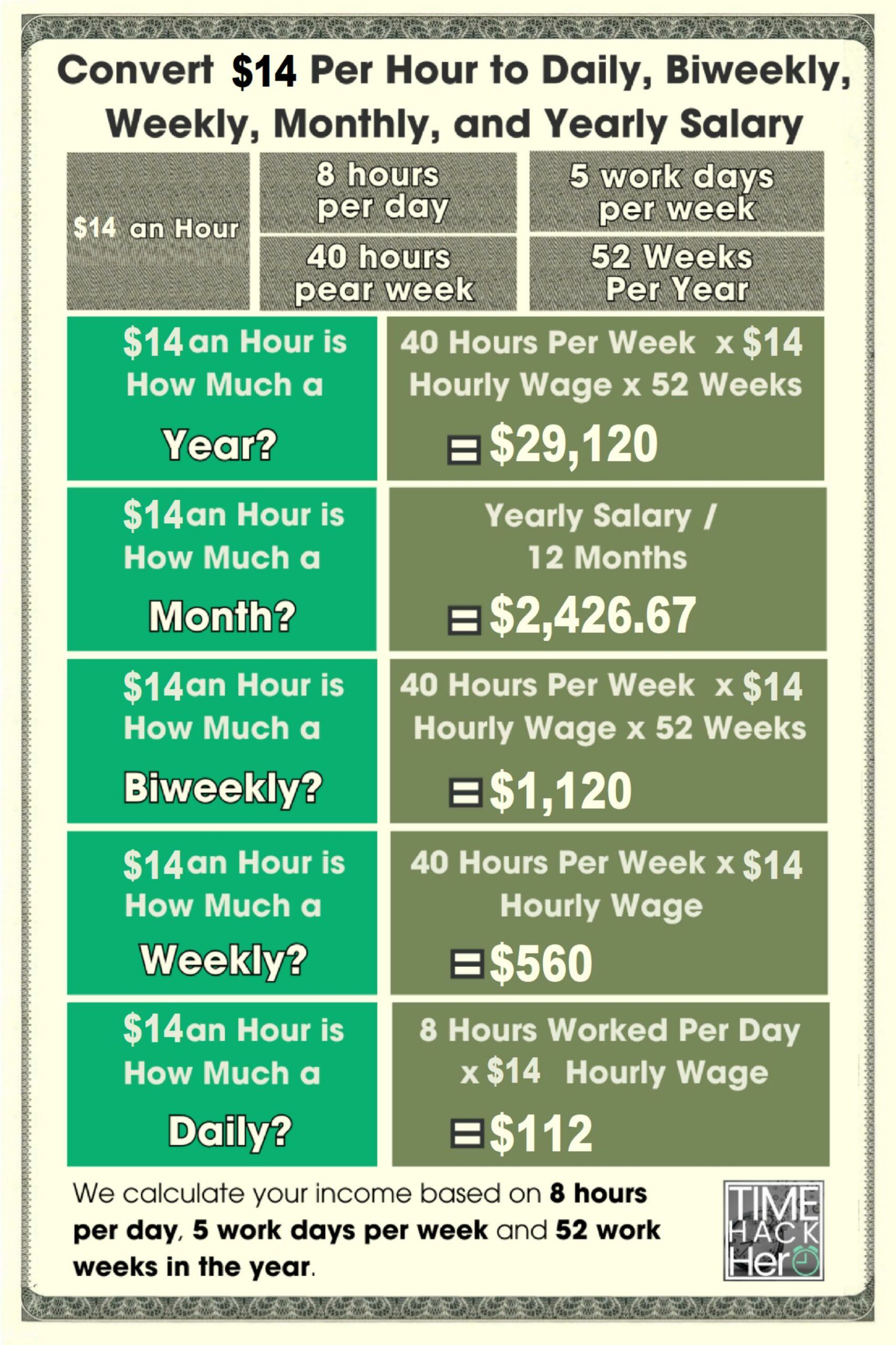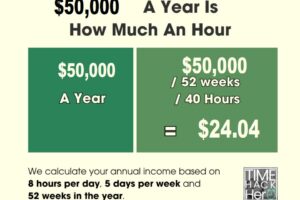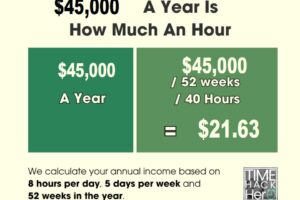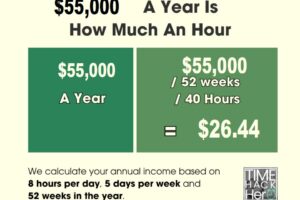With the cost of living on the rise, an hourly wage of $14 may leave some wondering if it is possible to earn a decent living. In this article, we will break down exactly how much you can expect to earn per year at $14 an hour based on full-time and part-time schedules. We will look at gross annual pay as well as net income after taxes. You’ll also learn how unpaid time off impacts actual yearly earnings, and whether $14 per hour provides a livable wage. If you currently make $14 an hour or hope to in the future, read on to see the yearly, monthly, biweekly, and weekly salaries $14 per hour equates to before and after taxes. We will examine jobs that typically pay $14 hourly, consider the impact of inflation, give tips to increase earnings, and look at sample budgets to evaluate if buying a house or car is realistic on this income. The goal is to give you a complete overview of what $14 an hour truly means from a financial perspective.
Table of Contents
Convert $14 Per Hour to Weekly, Monthly, and Yearly Salary
Input your wage and hours per week to see how much you’ll make monthly, yearly and more.
$14 an Hour is How Much a Year?
If you make $14 an hour, your yearly salary would be $29,120. We calculate your annual income based on 8 hours per day, 5 days per week and 52 weeks in the year.
Hours worked per week (40) x Hourly wage($14) x Weeks worked per year(52) = $29,120
$14 an Hour is How Much a Month?
If you make $14 an hour, your monthly salary would be $2,426.67. We calculated this number by dividing your annual income by 12 months.
Hours worked per week (40) x Hourly wage($14) x Weeks worked per year(52) / Months per Year(12) = $2,426.67
$14 an Hour is How Much a Biweekly?
If you make $14 an hour, your biweekly salary would be $1,120.
Hours worked per week (40) x Hourly wage($14) x 2 = $1,120
$14 an Hour is How Much a Week?
If you make $14 an hour, your weekly salary would be $560. Calculating based on 5 days per week and 8 hours each day.
Hours worked per week (40) x Hourly wage($14) = $560
$14 an Hour is How Much a Day?
If you make $14 an hour, your daily salary would be $112. We calculated your daily income based on 8 hours per day.
Hours worked per day (8) x Hourly wage($14) = $112
$14 an Hour is How Much a Year?
The basic formula to calculate your annual salary from an hourly wage is:
Hourly Rate x Hours Worked per Week x Number of Weeks Worked per Year = Annual Salary
So for a $20 per hour job:
$14 per hour x 40 hours per week x 52 weeks per year = $29,120
However, this simple calculation makes some assumptions:
- You will work 40 hours every week of the year
- You will not get any paid time off
Therefore, it represents your earnings if you worked every week of the year, without any vacation, holidays, or sick days.
Accounting for Paid Time Off
The $29,120 base salary does not yet factor in paid time off (PTO). Let’s assume the job provides:
- 2 weeks (10 days) paid vacation
- 6 paid holidays
- 3 paid sick days
This totals 19 paid days off, or nearly 4 weeks of PTO.
Importantly, this paid time off should not be deducted from the annual salary, since you still get paid for those days.
So with 4 weeks PTO, the annual salary would remain $29,120 .
Part time $14 an hour is How Much a Year?
Your annual income changes significantly if you work part-time and not full-time.
For example, let’s say you work 35 hours per week instead of 40. Here’s how you calculate your new yearly total:
$14 per hour x 35 hours per week x 52 weeks per year = $25,480
By working 5 fewer hours per week (35 instead of 40), your annual earnings at $14 an hour drop from $29,120 to $25,480.
That’s a $3,640 per year difference just by working part-time!
Here’s a table summarizing how your annual earnings change depending on how many hours you work per week at $14 an hour:
| Hours Per Week | Earnings Per Week | Annual Earnings |
|---|---|---|
| 40 | $560 | $29,120 |
| 35 | $490 | $25,480 |
| 30 | $420 | $21,840 |
| 25 | $350 | $18,200 |
| 20 | $280 | $14,560 |
| 15 | $210 | $10,920 |
The more hours per week, the higher your total yearly earnings. But part-time work allows for more life balance if you don’t need the full salary.
$14 an Hour With Overtime is How Much a Year?
Now let’s look at how overtime can increase your annual earnings.
Overtime kicks in once you work more than 40 hours in a week. Typically, you earn 1.5x your regular hourly wage for overtime hours.
So if you make $14 per hour normally, you would make $21 per hour for any hours over 40 in a week.
Here’s an example:
- You work 45 hours in a Week
- 40 regular hours paid at $14 per hour = $560
- 5 overtime hours paid at $21 per hour = $105
- Your total one Week earnings =$560 + $105 = $665
If you worked 45 hours each week for 52 weeks, here’s how your annual earnings increase thanks to overtime pay:
$665 per week x 52 weeks per year = $34,580
That’s $5,460 more than you’d earn working just 40 hours per week at $14 an hour.
Overtime can add up! But also consider taxes and work-life balance when deciding on extra hours.
Here’s a table summarizing how your annual earnings change depending on how many hours you work per week at $14 an hour:
| Overtime hours per work day | Hours Per Week | Earnings Per Week | Annual Earnings |
| 0 | 40 | $560 | $29,120 |
| 1 | 45 | $665 | $34,580 |
| 2 | 50 | $770 | $40,040 |
| 3 | 55 | $875 | $45,500 |
| 4 | 60 | $980 | $50,960 |
| 5 | 65 | $1,085 | $56,420 |
| 6 | 70 | $1,190 | $61,880 |
| 7 | 75 | $1,295 | $67,340 |
How Unpaid Time Off Impacts $14/Hour Yearly Earnings
So far we’ve assumed you work 52 paid weeks per year. Any unpaid time off will reduce your total income.
For example, let’s say you take 2 weeks of unpaid leave. That brings your paid weeks down to 50:
Hours worked per week (40) x Hourly wage($14) x Weeks worked per year(50) = $28,000 annual salary
With 2 weeks unpaid time off, your annual earnings at $14/hour would drop by $1,120.
The table below summarizes how your annual income changes depending on the number of weeks of unpaid leave.
| Weeks of unpaid leave | Paid weeks per year | Earnings Per Week | Annual Earnings |
| 0 | 52 | $560 | $29,120 |
| 1 | 51 | $560 | $28,560 |
| 2 | 50 | $560 | $28,000 |
| 3 | 49 | $560 | $27,440 |
| 4 | 48 | $560 | $26,880 |
| 5 | 47 | $560 | $26,320 |
| 6 | 46 | $560 | $25,760 |
| 7 | 45 | $560 | $25,200 |
Key Takeaways for $14 Hourly Wage
In summary, here are some key points on annual earnings when making $14 per hour:
- At 40 hours per week, you’ll earn $29,120 per year.
- Part-time of 30 hours/week results in $21,840 annual salary.
- Overtime pay can boost yearly earnings, e.g. $5,460 extra at 45 hours/week.
- Unpaid time off reduces your total income, around $1,120 less per 2 weeks off.
- Your specific situation and location impacts taxes and PTO.
Knowing your approximate annual salary and factors impacting it makes it easier to budget and plan your finances. The next step is calculating take-home pay after deductions like taxes.
$14 An Hour Is How Much A Year After Taxes
Figuring out your actual annual earnings based on an hourly wage can be complicated once taxes are taken into account. In addition to federal, state, and local income taxes, 7.65% of your gross pay also goes to Social Security and Medicare through FICA payroll taxes. So how much does $14 an hour equal per year after FICA and income taxes are deducted from your gross pay?
Below we’ll walk through the steps to calculate your annual net take home pay if you make $14 per hour. This will factor in estimated federal, FICA, state, and local taxes so you know exactly what to expect.
Factoring in Federal Income Tax
Your federal income tax will be a big chunk out of your gross pay. Federal tax rates range from 10% to 37%, depending on your tax bracket.
To estimate your federal income tax rate and liability:
Look up your federal income tax bracket based on your gross pay.
2023 tax brackets: single filers
| Tax rate | Taxable income bracket | Tax owed |
|---|---|---|
| 10% | $0 to $11,000. | 10% of taxable income. |
| 12% | $11,001 to $44,725. | $1,100 plus 12% of the amount over $11,000. |
| 22% | $44,726 to $95,375. | $5,147 plus 22% of the amount over $44,725. |
| 24% | $95,376 to $182,100. | $16,290 plus 24% of the amount over $95,375. |
| 32% | $182,101 to $231,250. | $37,104 plus 32% of the amount over $182,100. |
| 35% | $231,251 to $578,125. | $52,832 plus 35% of the amount over $231,250. |
| 37% | $578,126 or more. | $174,238.25 plus 37% of the amount over $578,125. |
For example, if you are single with $29,120 gross annual pay, your federal tax bracket is 12%.
Your estimated federal tax would be:
$1,100 + ($29,120 – $11,000) x 12% = $3,274.40
So at $14/hour with $29,120 gross pay, you would owe about $3,274.40 in federal income taxes.
Considering State Income Tax
In addition to federal tax, most states also charge a state income tax. State income tax rates range from about 1% to 13%, with most falling between 4% and 6%.
Key Takeaways
-
- California, Hawaii, New York, New Jersey, and Oregon have some of the highest state income tax rates.
- Alaska, Florida, Nevada, South Dakota, Tennessee, Texas, Washington, and Wyoming don’t impose an income tax at all.
- Another 10 U.S states have a flat tax rate—everyone pays the same percentage regardless of how much they earn.
A State-by-State Comparison of Income Tax Rates
| STATE | TAX RATES | LOWEST AND HIGHEST INCOME BRACKETS |
|---|---|---|
| Alaska | 0% | None |
| Florida | 0% | None |
| Nevada | 0% | None |
| South Dakota | 0% | None |
| Tennessee | 0% | None |
| Texas | 0% | None |
| Washington | 0% | None |
| Wyoming | 0% | None |
| Colorado | 4.55% | Flat rate applies to all incomes |
| Illinois | 4.95% | Flat rate applies to all incomes |
| Indiana | 3.23% | Flat rate applies to all incomes |
| Kentucky | 5% | Flat rate applies to all incomes |
| Massachusetts | 5% | Flat rate applies to all incomes |
| New Hampshire | 5% | Flat rate on interest and dividend income only |
| North Carolina | 4.99% | Flat rate applies to all incomes |
| Pennsylvania | 3.07% | Flat rate applies to all incomes |
| Utah | 4.95% | Flat rate applies to all incomes |
| Michigan | 4.25% | Flat rate applies to all incomes |
| Arizona | 2.59% to 4.5% | $27,806 and $166,843 |
| Arkansas | 2% to 5.5% | $4,300 and $8,501 |
| California | 1% to 13.3% | $9,325 and $1 million |
| Connecticut | 3% to 6.99% | $10,000 and $500,000 |
| Delaware | 0% to 6.6% | $2,000 and $60,001 |
| Alabama | 2% to 5% | $500 and $3,001 |
| Georgia | 1% to 5.75% | $750 and $7,001 |
| Hawaii | 1.4% to 11% | $2,400 and $200,000 |
| Idaho | 1.125% to 6.5% | $1,568 and $7,939 |
| Iowa | 0.33% to 8.53% | $1,743 and $78,435 |
| Kansas | 3.1% to 5.7% | $15,000 and $30,000 |
| Louisiana | 1.85% to 4.25% | $12,500 and $50,001 |
| Maine | 5.8% to 7.15% | $23,000 and $54,450 |
| Maryland | 2% to 5.75% | $1,000 and $250,000 |
| Minnesota | 5.35% to 9.85% | $28,080 and $171,221 |
| Mississippi | 0% to 5% | $5,000 and $10,001 |
| Missouri | 1.5% to 5.3% | $1,121 and $8,968 |
| Montana | 1% to 6.75% | $2,900and $17,400 |
| Nebraska | 2.46% to 6.84% | $3,340 and $32,210 |
| New Jersey | 1.4% to 10.75% | $20,000 and $1 million |
| New Mexico | 1.7% to 5.9% | $5,500 and $210,000 |
| New York | 4% to 10.9% | $8,500 and $25 million |
| North Dakota | 1.1% to 2.9% | $41,775 and $458,350 |
| Ohio | 0% to 3.99% | $25,000 and $110,650 |
| Oklahoma | 0.25% to 4.75% | $1,000 and $7,200 |
| Oregon | 4.75% to 9.9% | $3,750 and $125,000 |
| Rhode Island | 3.75% to 5.99% | $68,200 and $155,050 |
| South Carolina | 0% to 7% | $3,110 and $15,560 |
| Vermont | 3.35% to 8.75% | $42,150 and $213,150 |
| Virginia | 2% to 5.75% | $3,000 and $17,001 |
| Washington, D.C. | 4% to 9.75% | $10,000 and $1 million |
| West Virginia | 3% to 6.5% | $10,000 and $60,000 |
| Wisconsin | 3.54% to 7.65% | $12,760 and $280,950 |
To estimate your state income tax:
Look up your state income tax rate based on your gross pay and filing status.
Multiply your gross annual pay by the state tax rate.
For example, if you live in Pennsylvania which has a flat 3.07% tax rate, your estimated state tax would be:
$29,120 gross pay x 3.07% PA tax rate = $893.98 estimated state income tax
So with $29,120 gross annual income, you would owe around in $893.98 Pennsylvania state income tax. Verify your specific state’s income tax rates.
Factoring in Local Taxes
Some cities and counties levy local income taxes ranging from 1-3% of taxable income.
To estimate potential local taxes you may owe:
- Check if your city or county charges a local income tax.
- If yes, look up the local income tax rate.
- Multiply your gross annual pay by the local tax rate.
For example, say you live in Columbus, OH which has a 2.5% local income tax. Your estimated local tax would be:
$29,120 gross pay x 2.5% local tax rate = $728 estimated local tax
So with $29,120 in gross earnings, you may owe around $728 in Columbus local income taxes. Verify rates for your own city/county.
Accounting for FICA Taxes (Social Security & Medicare)
FICA taxes are a combination of Social Security and Medicare taxes that equal 15.3% of your earnings. You are responsible for half of the total bill (7.65%), which includes a 6.2% Social Security tax and 1.45% Medicare tax on your earnings.
In 2023, only the first $160,200 of your earnings are subject to the Social Security tax
There is an additional 0.9% surtax on top of the standard 1.45% Medicare tax for those who earn over $200,000 (single filers) or $250,000 (joint filers).
To estimate your FICA tax payment:
$29,120 x 6.2% + $29,120 x 1.45% = $2,227.68
So you can expect to pay about $2,227.68 in Social Security and Medicare taxes out of your gross $29,120 in earnings.
Total Estimated Tax Payments
Based on the examples above, your total estimated tax payments would be:
Federal tax: $3,274.40
State tax: $893.98
Local tax: $728
FICA tax: $2,227.68
Total Estimated Tax: $7,124.06
Calculating Your Take Home Pay
To calculate your annual take home pay at $14 /hour:
1. Take your gross pay
2. Subtract your estimated total tax payments
$29,120 gross pay – $7,124.06 Total Estimated Tax = $21,995.94 Your Take Home Pay
n summary, if you make $14 per hour and work full-time, you would take home around $21,995.94 per year after federal, state, local , FICA taxes.
Your actual net income may vary depending on your specific tax situation. But this gives you a general idea of what to expect.
Convert $14 Per Hour to Yearly, Monthly, Biweekly, and Weekly Salary After Taxes
If you make $14 an hour and work full-time (40 hours per week), your estimated yearly salary would be $29,120 .
The $29,120 per year salary does not account for taxes. Federal, state, and local taxes will reduce your take-home pay. The amount withheld depends on your location, filing status, dependents, and other factors.
Just now during our calculation of $14 An Hour Is How Much A Year After Taxes, we assumed the following conditions:
- You are single with $29,120 gross annual pay, your federal tax bracket is 12 %.
- You live in Pennsylvania which has a flat 3.07% tax rate
- You live in Columbus, OH which has a 2.5% local income tax.
In the end, we calculated your Total Estimated Tax is $7,124.06 , Your Take Home Pay is $21,995.94 , Total tax rate is 24.46%.
So next we’ll use 24.46% as the estimated tax rate to calculate your weekly, biweekly, and monthly after-tax income.
$14 Per Hour to Yearly, Monthly, Biweekly, Weekly,and Week Salary After Taxes Table
| Income before taxes | Estimated Tax Rate | Income Taxes | After Tax Income | |
| Yearly Salary | $29,120 | 24.46% | $7,124.06 | $21,995.94 |
| Monthly Salary | $2,426.67 | 24.46% | $593.67 | $1,832.99 |
| BiWeekly Salary | $1,120 | 24.46% | $274 | $846 |
| Weekly Salary | $560 | 24.46% | $137 | $423 |
$14 an hour is how much a year after taxes
Here is the adjusted yearly salary after a 24.46% tax reduction:
-
- Yearly salary before taxes: $29,120
- Estimated tax rate: 24.46%
- Taxes owed (24.46% * $29,120 )= $7,124.06
- Yearly salary after taxes: $21,995.94
| Hourly Wage | Hours Worked Per Week | Weeks Worked Per Year | Total Yearly Salary | Estimated Tax Rate | Taxes Owed | After-Tax Yearly Salary |
|---|---|---|---|---|---|---|
| $14 | 40 | 52 | $29,120 | 24.46% | $7,124.06 | $21,995.94 |
$14 an hour is how much a month after taxes
To calculate the monthly salary based on an hourly wage, you first need the yearly salary amount. Then divide by 12 months.
-
-
- Yearly salary before taxes at $14 per hour: $29,120
- Divided by 12 months per year: $29,120 / 12 = $2,426.67 per month
-
The monthly salary based on a 40 hour work week at $14 per hour is $2,426.67 before taxes.
After applying the estimated 24.46% tax rate, the monthly after-tax salary would be:
-
- Monthly before-tax salary: $2,426.67
- Estimated tax rate: 24.46%
- Taxes owed (24.46% * $2,426.67 )= $593.67
- Monthly after-tax salary: $1,832.99
Monthly Salary Based on $14 Per Hour
| Hourly Wage | Yearly Salary | Months Per Year | Before-Tax Monthly Salary | Estimated Tax Rate | Taxes Owed | After-Tax Monthly Salary |
|---|---|---|---|---|---|---|
| $14 | $29,120 | 12 | $2,426.67 | 24.46% | $593.67 | $1,832.99 |
$14 an hour is how much biweekly after taxes
Many people are paid biweekly, meaning every other week. To calculate the biweekly pay at $14 per hour:
- Hourly wage: $14
- Hours worked per week: 40
- Weeks per biweekly pay period: 2
- $14 * 40 hours * 2 weeks = $1,120 biweekly
Applying the 24.46%estimated tax rate:
- Biweekly before-tax salary: $1,120
- Estimated tax rate: 24.46%
- Taxes owed (24.46% * $1,120 )= $274
- Biweekly after-tax salary: $846
Biweekly Salary at $14 Per Hour
| Hourly Wage | Hours Worked Per Week | Weeks Per Pay Period | Before-Tax Biweekly Salary | Estimated Tax Rate | Taxes Owed | After-Tax Biweekly Salary |
|---|---|---|---|---|---|---|
| $14 | 40 | 2 | $1,120 | 24.46% | $274 | $846 |
$14 an hour is how much weekly after taxes
To find the weekly salary based on an hourly wage, you need to know the number of hours worked per week. At 40 hours per week, the calculation is:
- Hourly wage: $14
- Hours worked per week: 40
- $14 * 40 hours = $560 per week
Accounting for the estimated 24.46% tax rate:
- Weekly before-tax salary: $560
- Estimated tax rate: 24.46%
- Taxes owed (24.46% * $560 )= $137
- Weekly after-tax salary: $423
Weekly Salary at $14 Per Hour
| Hourly Wage | Hours Worked Per Week | Before-Tax Weekly Salary | Estimated Tax Rate | Taxes Owed | After-Tax Weekly Salary |
|---|---|---|---|---|---|
| $14 | 40 | $560 | 24.46% | $137 | $423 |
Key Takeaways
- An hourly wage of $14 per hour equals a yearly salary of $29,120 before taxes, assuming a 40 hour work week.
- After accounting for an estimated 24.46% tax rate, the yearly after-tax salary is approximately $21,995.94 .
- On a monthly basis before taxes, $14 per hour equals $2,426.67 per month. After estimated taxes, the monthly take-home pay is about $1,832.99 .
- The before-tax weekly salary at $14 per hour is $560 . After taxes, the weekly take-home pay is approximately $423 .
- For biweekly pay, the pre-tax salary at $14 per hour is $1,120 . After estimated taxes, the biweekly take-home pay is around $846 .
Understanding annual, monthly, weekly, and biweekly salary equivalents based on an hourly wage is useful when budgeting and financial planning. Taxes make a significant difference in take-home pay, so be sure to account for them when making income conversions. Use this guide as a reference when making salary calculations.
What Is the Average Hourly Wage in the US?
Last Updated: Sep 1 2023
US Average Hourly Earnings is at a current level of $33.82, up from 33.74 last month and up from 32.43 one year ago. This is a change of 0.24% from last month and 4.29% from one year ago.
Average Hourly Earnings is the average dollars that a private employee makes per hour in the US. This metric is a part of one of the most important releases every month which includes unemployment numbers as well. This is normally released on the first Friday of every month. This metric is released by the Bureau of Labor Statistics (BLS).
What is the average salary in the U.S.?
Last Updated: July 18, 2023
The U.S. Bureau of Labor Statistics uses median salary data rather than averages to avoid skewed numbers from outlying high and low numbers. Median weekly earnings of the nation's 121.5 million full-time wage and salary workers were $1,100 in the second quarter of 2023, the U.S.
If a person works 52 weeks in the year, then this represents a national annual salary of $57,200.
Is $14 an Hour a Good Salary?
For many Americans, $14 an hour is considered a low wage, but it’s still nearly double the federal minimum wage of $7.25 an hour. At $14 an hour, working 40 hours per week year-round (no overtime), your annual pre-tax income would be around $29,120. That puts you well above the 2023 federal poverty level of $13,590 for an individual, but potentially straining to support a family.
The average hourly wage in the US is around $27 an hour. So at $14 an hour, you’re making about half of the national average. However, wages also vary significantly by state and region. In states like California or New York, $14 an hour would be very difficult to live on. But in some southern or midwestern states, the lower cost of living would make $14 an hour more manageable.
Jobs that pay $14 an hour
There are a variety of jobs that typically pay around $14 per hour:
- Retail salesperson – Working in retail clothing stores, department stores, or other retail outlets often pays around $14/hr for entry level work. Retail jobs usually don’t require formal education.
- Food service – Fast food workers, dishwashers, hosts, servers, and some cooks in restaurants frequently earn $13-15 per hour. Tipping can supplement servers’ incomes.
- Warehouse worker – General warehouse jobs filling orders, receiving inventory, packing and shipping packages often pay $14-16/hr. Physical stamina is required.
- Home health aide – Caring for elderly or disabled clients in their homes is rewarding but pays just $12-16/hr typically. No experience required.
- Hotel staff – Front desk clerks, housekeepers, janitors, and other hotel staff often earn around $13-15/hr depending on the hotel.
- Gig jobs – Driving for Uber or Lyft, delivering for Instacart or DoorDash, walking dogs through Wag or Rover, and other gig jobs can bring in $14-18/hr or more depending on hours and tips. Flexible schedules.
- Childcare – Daycare assistants, nannies, babysitters typically earn $12-15/hr depending on experience and number of children. Must enjoy kids.
- Entry level office work – Receptionists, data entry clerks, assistants, and other entry level office roles often pay $14-16/hr.
Can You Live Off $14 An Hour?
While it’s possible to live independently on $14 an hour, it requires strict budgeting and likely some sacrifices in housing, transportation, and discretionary spending. You would need to be diligent about controlling costs but it can be done, especially with roommates or a working spouse/partner. Let’s take a look at some typical costs:
- Housing – Renting your own one bedroom apartment is tough on $14/hr. Living with roommates or family sharing a 2-3 bedroom unit is more realistic. Average rent for a 1 bedroom apartment is around $1,100/month nationwide.
- Food – Groceries and dining out will easily cost $300+ per month even on a tight food budget. Smart meal planning, buying generics, avoiding waste, and limiting eating out can help control costs.
- Utilities – Budget $150-250/month for electricity, internet, cell phone, and other utilities. Cut the cable cord for big savings. Use prepaid discount cell plans.
- Transportation – Owning a car is expensive. Consider public transit if available. Average monthly car payment is $400 for a used car plus gas and insurance.
- Health Insurance – If your employer doesn’t provide health insurance, factor in $300-500/month for an ACA marketplace plan with subsidies.
- Taxes – After standard deductions, expect to pay about 10-15% in Federal and State taxes on $14/hr income. Budget for tax payments.
As you can see, housing and transportation costs alone could easily consume a $14/hr income. Minimizing fixed costs, avoiding debt, and limiting discretionary spending is essential for staying afloat. Having a partner to share costs helps tremendously as well.
The impact of inflation on the value of $14 an hour
Inflation has been persistently high in 2022-2023, averaging 8-9% annually. This rapid inflation quickly erodes the buying power of wages like $14/hr.
For example, in 2020 when inflation was low, $14/hr provided the equivalent buying power of about $16.50 today. So in real terms, $14/hr has lost significant value recently.
If inflation remains high at 7-9% in coming years, the effective buying power of $14/hr will continue to decline. What costs $14 today would cost over $18 in 5 years at 8% annual inflation.
This illustrates why it’s so important for hourly wages to increase at least as fast as inflation. Otherwise, workers are essentially taking a pay cut each year. Fighting for raises and higher minimum wages helps protect incomes from inflation.
5 Ways To Increase Your Hourly Wage
If you’re struggling to pay the bills on $14/hr, here are some strategies to boost your income:
- Ask for a raise – If you’ve been with your employer for over a year with good performance, request a raise to $15/hr or more. Come prepared citing your contributions.
- Find a higher paying job – Explore other jobs in your field paying $15-18/hr. Update your resume and network.
- Develop new skills – Take courses to gain skills that command higher pay, such as computer skills, trades, or certifications.
- Negotiate overtime hours – Ask to work extra hours for time-and-a-half pay if feasible. Even 5 hours OT per week adds up.
- Get a side gig – Drive for Uber, walk dogs, or find other side jobs to earn supplemental income. Every bit helps.
Putting in this work upfront can potentially boost your earnings by $2-5 per hour. That extra income goes a long way at this pay scale. Don’t sell yourself short – know your worth.
Buying a car on $14 an hour
Buying a car is extremely challenging on a $14/hr budget. Here are some tips to make it more affordable:
- Buy used – Focus on a reliable used car that’s 5-10 years old. Let someone else take the depreciation hit.
- Save up a downpayment – Try to put at least 20% down to keep payments manageable. Finance no more than $10,000.
- Boost your credit – Excellent credit (700+ score) gets the best rates. Pay all bills on time.
- Get pre-approved – Shop rates at local credit unions. They often offer the lowest rates.
- Extend the term – Stretch the loan to 5-6 years to get lower monthly payments.
- Buy cheaper insurance – Get just basic liability coverage if money is very tight.
- Limit mileage – Choose a car with lower than 12,000 miles/year for lower insurance.
- Allow for maintenance – Budget $50/month for gas and maintenance costs.
Following this advice makes a used Toyota or Honda in the $10k range feasible. Just beware of breakdowns on ultra-cheap cars. regular maintenance is critical. Building savings for a larger downpayment takes discipline but pays off.
Can You Buy a House on $14 An Hour?
Buying a home on a single $14/hr income is extremely difficult today. However, here are a few scenarios where home ownership may be possible:
- Have a partner/spouse who also earns income – Combining dual incomes of even $30,000-$40,000 total can make an FHA loan possible. Save aggressively for a 3.5% downpayment.
- VA or USDA loan programs – If you qualify for a zero down VA or rural USDA home loan, buying may be within reach. These have income limits though.
- Save a large downpayment – If you can save 20-25% for a downpayment over many years, a conventional mortgage becomes an option. challenging on $14/hr.
- Shared/multi-family housing – One idea is to purchase a duplex, triplex, or other multi-family home. Renters help cover costs.
- Local downpayment assistance – Look into State/local downpayment assistance grants. These provide funds to cover all or part of the downpayment.
- Lower cost markets – Buying is more realistic in very affordable markets like Midwest, South, etc. Focus on under $150k homes.
As you can see, buying a home on a single income of $14/hr will be very difficult in today’s high home price environment. But it’s still possible in some circumstances with discipline and creativity. Don’t give up on the dream of home ownership.
Example Budget For $14 Per Hour
Here is one example of a monthly budget for someone earning $14/hr or about $2,400 per month after tax:
- Rent (shared apartment/home) – $600
- Groceries – $250
- Utilities – $150
- Prepaid cell phone plan – $40
- Cheap car payment – $150
- Car gas and insurance – $150
- Health insurance (ACA with subsidies) – $200
- Entertainment/dining out – $100
- Clothing/Personal care – $50
- Total Fixed Costs – $1,690
This leaves about $700 per month in flexible spending for savings goals, debt repayment, home/car repairs, medical copays, etc.
It’s a very lean budget requiring discipline and smart choices like roommate living, eating in, and limiting debt. Building emergency savings is crucial to cushion unexpected expenses. Overall, living on $14/hr is challenging but can be managed with frugality.
In Summary
While $14 an hour is considered a low wage, it is certainly better than minimum wage. With careful budgeting, lean spending, and supplemental income sources, it is possible to live independently on this salary. However, you’ll need to make some sacrifices around housing, transportation, debt levels, and discretionary purchases.
Sharing costs with roommates or a partner are huge advantages. So is minimizing fixed costs wherever possible. second jobs or side gigs can provide a earnings boost when needed.
Most importantly, be diligent about increasing your income over time through raises, education, training, and job moves. $14 an hour is a good starting point, but you’ll want to keep growing your earnings to build savings and gain financial stability. With hard work, creativity and smart money choices, you can build a solid financial life even starting at $14 an hour.










